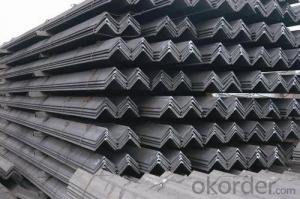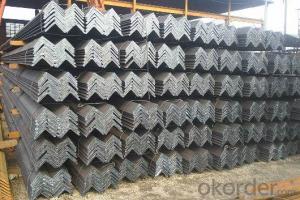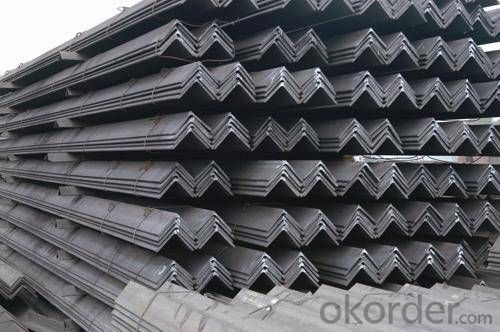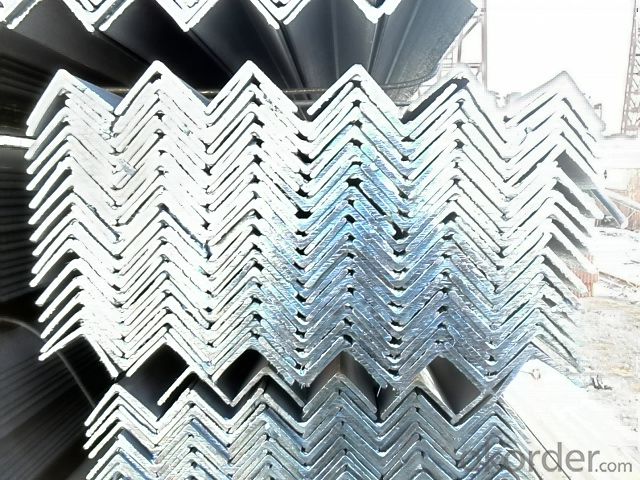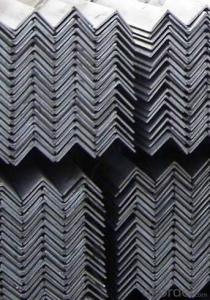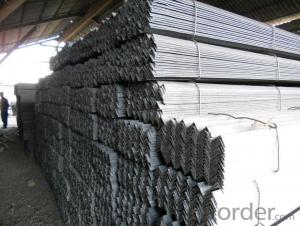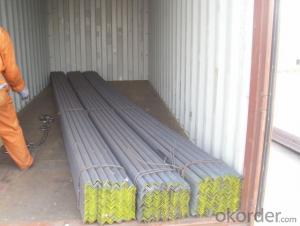Equal Steel Angles in Material Grade GB-Q235
- Loading Port:
- Tianjin
- Payment Terms:
- TT OR LC
- Min Order Qty:
- 25 m.t
- Supply Capability:
- 10000 m.t/month
OKorder Service Pledge
OKorder Financial Service
You Might Also Like
Product Description:
OKorder is offering high quality Hot Rolled Equal Angle Steel at great prices with worldwide shipping. Our supplier is a world-class manufacturer of steel, with our products utilized the world over. OKorder annually supplies products to European, North American and Asian markets. We provide quotations within 24 hours of receiving an inquiry and guarantee competitive prices.
Product Applications:
Hot Rolled Equal Angle Steels are ideal for structural applications and are widely used in the construction of buildings and bridges, and the manufacturing, petrochemical, and transportation industries.
Product Advantages:
OKorder's Hot Rolled Equal Angle Steels are durable, strong, and resist corrosion.
Main Product Features:
· Premium quality
· Prompt delivery & seaworthy packing (30 days after receiving deposit)
· Corrosion resistance
· Can be recycled and reused
· Mill test certification
· Professional Service
· Competitive pricing
Product Specifications:
Manufacture: Hot rolled
Grade: Q195 – 235
Certificates: ISO, SGS, BV, CIQ
Length: 6m – 12m, as per customer request
Packaging: Export packing, nude packing, bundled
EQUAL ANGLES SIZES |
| ||
a(mm) | a1(mm) | thickness(mm) | length |
25 | 25 | 2.5---3.0 | 6M/12M |
30 | 30 | 2.5---4.0 | 6M/12M |
38 | 38 | 2.5 | 6M/12M |
38 | 38 | 3.0---5.0 | 6M/12M |
40 | 40 | 3.0---6.0 | 6M/12M |
50 | 50 | 3 | 6M/12M |
50 | 50 | 3.7---6.0 | 6M/9M/12M |
60 | 60 | 5.0---6.0 | 6M/9M/12M |
63 | 63 | 6.0---8.0 | 6M/9M/12M |
65 | 65 | 5.0---8.0 | 6M/9M/12M |
70 | 70 | 6.0---7.0 | 6M/9M/12M |
75 | 75 | 5.0---10.0 | 6M/9M/12M |
80 | 80 | 6.0---10.0 | 6M/9M/12M |
90 | 90 | 6.0---10.0 | 6M/9M/12M |
100 | 100 | 6.0---12.0 | 6M/9M/12M |
120 | 120 | 8.0-12.0 | 6M/9M/12M |
125 | 125 | 8.0---12.0 | 6M/9M/12M |
130 | 130 | 9.0-12.0 | 6M/9M/12M |
140 | 140 | 10.0-16.0 | 6M/9M/12M |
150 | 150 | 10---15 | 6M/9M/12M |
160 | 160 | 10---16 | 6M/9M/12M |
180 | 180 | 12---18 | 6M/9M/12M |
200 | 200 | 14---20 | 6M/9M/12M |
FAQ:
Q1: Why buy Materials & Equipment from OKorder.com?
A1: All products offered byOKorder.com are carefully selected from China's most reliable manufacturing enterprises. Through its ISO certifications, OKorder.com adheres to the highest standards and a commitment to supply chain safety and customer satisfaction.
Q2: What makes stainless steel stainless?
A2: Stainless steel must contain at least 10.5 % chromium. It is this element that reacts with the oxygen in the air to form a complex chrome-oxide surface layer that is invisible but strong enough to prevent further oxygen from "staining" (rusting) the surface. Higher levels of chromium and the addition of other alloying elements such as nickel and molybdenum enhance this surface layer and improve the corrosion resistance of the stainless material.
Q3: The products are invoicing on theoritical weight or on actual weight?
A3: We can do it in both manners, according to the customers' request.
Images:
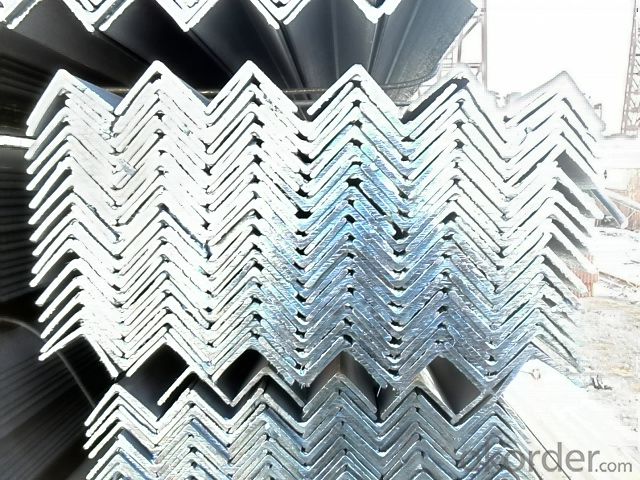
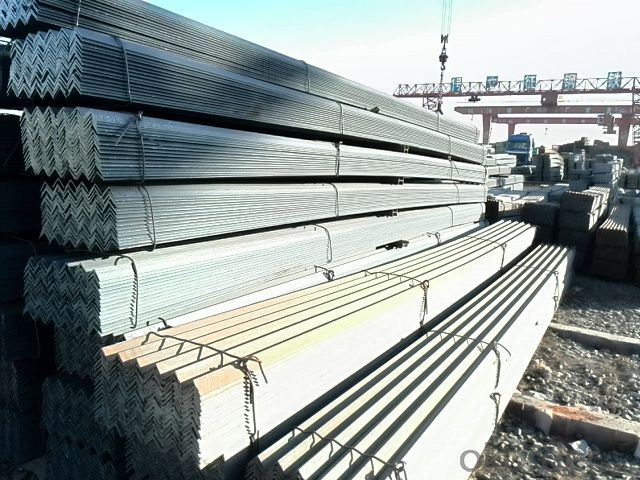
- Q: What are the common welding techniques for steel angles?
- Some common welding techniques for steel angles include: 1. Shielded Metal Arc Welding (SMAW): Also known as stick welding, SMAW is a popular technique for welding steel angles. It involves using a consumable electrode coated in flux, which creates a protective shield around the weld pool. SMAW is versatile and can be used for various thicknesses of steel angles. 2. Gas Metal Arc Welding (GMAW): This technique, also known as MIG welding, uses a continuous wire electrode and a shielding gas, typically a mixture of argon and carbon dioxide. GMAW offers high welding speeds and good control over the weld pool, making it suitable for welding steel angles. 3. Flux-Cored Arc Welding (FCAW): Similar to GMAW, FCAW uses a continuous wire electrode, but instead of a shielding gas, it utilizes a flux-filled wire. This flux creates a protective gas shield when heated, preventing contamination of the weld. FCAW is ideal for outdoor welding or in windy conditions. 4. Gas Tungsten Arc Welding (GTAW): Also known as TIG welding, GTAW uses a non-consumable tungsten electrode and a shielding gas, usually argon. GTAW is a precise and clean welding process that produces high-quality welds on steel angles. It is commonly used for thin steel angles or when aesthetics and control are crucial. 5. Submerged Arc Welding (SAW): SAW is a semi-automatic or automatic welding process that involves feeding a continuous wire electrode and a granular flux into the weld zone. The flux covers the weld, preventing atmospheric contamination. SAW is often used for thicker steel angles and provides high deposition rates. It is important to choose the appropriate welding technique based on the specific requirements of the steel angle joint, such as thickness, joint design, and desired weld quality. Additionally, proper preparation, including cleaning and preheating if necessary, is essential to ensure successful welds on steel angles.
- Q: What are the common surface treatments for steel angles?
- There are several common surface treatments for steel angles, depending on the desired application and level of corrosion resistance required. Some of the most common surface treatments include: 1. Hot-dip galvanizing: This process involves immersing the steel angles in a bath of molten zinc, which forms a protective layer on the surface. Hot-dip galvanizing provides excellent corrosion resistance and is commonly used in outdoor applications. 2. Powder coating: Powder coating involves applying a dry powder to the surface of the steel angles, which is then cured under heat to form a protective and decorative coating. Powder coating is highly durable and provides good corrosion resistance, making it suitable for both indoor and outdoor applications. 3. Paint: Painting steel angles is a cost-effective and versatile surface treatment option. The steel angles are typically primed with a rust-inhibiting primer and then painted with a suitable topcoat. Paint provides a decorative finish and some level of corrosion resistance, although it may not be as long-lasting as other treatments. 4. Electroplating: Electroplating is a process where a thin layer of metal, such as zinc or chrome, is deposited onto the surface of the steel angles using an electric current. This treatment provides both corrosion resistance and aesthetic appeal, making it suitable for various applications. 5. Anodizing: Anodizing is typically used for aluminum, but it can also be applied to steel angles. This process involves creating an oxide layer on the surface of the metal, which provides corrosion resistance and improved durability. Anodizing can also provide a decorative finish and is commonly used in architectural applications. It's important to note that the choice of surface treatment for steel angles depends on factors such as the intended use, budget, and environmental conditions. Consulting with professionals or experts in the field can help determine the most suitable surface treatment for a specific application.
- Q: What are the different types of steel angles used in scaffolding?
- There are several types of steel angles commonly used in scaffolding. These include: 1. Equal Angle: This type of steel angle has equal sides and is often used as a base or support in scaffolding structures. It provides stability and strength to the scaffolding system. 2. Unequal Angle: As the name suggests, this type of steel angle has unequal sides. It is used when there is a need for different lengths on each side, such as for creating diagonal bracing or for connecting different parts of the scaffolding system. 3. L-Shaped Angle: This steel angle has a 90-degree angle and is commonly used for creating corners or connecting two perpendicular scaffolding components. It offers structural support and stability to the scaffolding structure. 4. T-Shaped Angle: This type of steel angle has a T-shape and is used to connect two perpendicular scaffolding components. It provides stability and support to the scaffolding system. 5. Channel Angle: This steel angle has a U-shaped channel and is often used as a top or bottom cross member in scaffolding structures. Its design allows for easy attachment of scaffolding components and provides strength to the overall scaffolding system. These different types of steel angles offer versatility and strength to scaffolding structures, allowing for various configurations and designs based on the specific requirements of the project.
- Q: What are the different finishes available for steel angles?
- There are several different finishes available for steel angles, including hot-dip galvanized, mill finish, painted, and powder coated.
- Q: What is the thickness of the national standard 8# angle steel? Thank you
- Test method: to test the chemical composition, test methods commonly used standards GB223, JISG1211-1215, BS1837, BS, C, f 19 manual is 22536.
- Q: Can steel angles be used for machinery frames?
- Certainly, machinery frames can utilize steel angles. The construction and manufacturing industries frequently employ steel angles due to their robustness and adaptability. They serve as a means of furnishing structural reinforcement and stability in a multitude of applications, including machinery frames. Steel angles present an economically viable option as they are readily accessible and can be conveniently crafted to meet precise design specifications. Moreover, steel angles exhibit exceptional load-bearing capability and resistance to deformation, rendering them well-suited for supporting hefty machinery and equipment. Their inflexible and long-lasting characteristics guarantee the steadfastness and endurance of machinery frames, establishing them as a dependable choice within industrial environments.
- Q: How do you calculate the torsional strength of a steel angle?
- In order to calculate the torsional strength of a steel angle, several factors must be considered. First and foremost, it is crucial to determine the moment of inertia of the steel angle's cross-section. This can be achieved by utilizing the formula for the moment of inertia of a rectangular shape, namely (b * h^3)/12. Here, b represents the base width and h stands for the angle's height. Once the moment of inertia is established, it becomes possible to calculate the maximum shear stress using the equation T = (M * c)/I. In this formula, T signifies the torsional strength, M denotes the applied torque, c represents the distance from the centroid of the angle to the outermost fiber, and I symbolizes the moment of inertia. Determining the maximum allowable shear stress for the steel angle is achievable by taking into account the material properties of the steel. This value can be retrieved from engineering handbooks or specifications. Lastly, the torsional strength of the steel angle can be calculated by multiplying the maximum allowable shear stress by the moment of inertia of the angle. It is important to note that this calculation assumes the steel angle is only subjected to pure torsion, without any bending or additional external loads. If the angle is exposed to combined loads, more intricate calculations may be necessary to determine the torsional strength.
- Q: What are the different types of steel angles connections for mezzanine floors?
- There are several different types of steel angle connections that can be used for mezzanine floors. These connections are designed to provide structural stability and support for the floor, ensuring that it can safely accommodate the intended loads and usage. 1. Bolted Connections: Bolted connections are commonly used in mezzanine floors as they offer a strong and secure connection. These connections involve using bolts to attach the steel angles together, creating a rigid and stable framework. Bolted connections can be easily adjusted or disassembled if required. 2. Welded Connections: Welded connections involve joining the steel angles using welding techniques. This type of connection provides a permanent and strong bond between the angles, ensuring maximum stability. Welded connections are often preferred for heavy-duty mezzanine floors where high load-bearing capacity is required. 3. Clip Connections: Clip connections are a popular choice for mezzanine floors as they offer ease of installation and flexibility. These connections involve using metal clips or brackets to secure the steel angles together. Clip connections can be easily adjusted or disassembled, allowing for future modifications or reconfigurations of the mezzanine floor layout. 4. Gusset Plate Connections: Gusset plate connections involve using additional steel plates, known as gusset plates, to reinforce the joint between the steel angles. These plates are typically welded or bolted to the angles, providing added strength and stability to the connection. Gusset plate connections are commonly used in mezzanine floors where extra reinforcement is necessary. 5. Cleat Connections: Cleat connections involve using a cleat plate to connect two steel angles. The cleat plate is attached to one angle, while the other angle is bolted or welded to the plate. This type of connection provides a strong and secure joint, particularly when used with heavy-duty mezzanine floors. It is essential to ensure that the chosen steel angle connections for mezzanine floors are in compliance with local building codes and regulations. Additionally, consulting a structural engineer or a professional with expertise in mezzanine floor construction is recommended to ensure the connections are designed and installed correctly for optimal safety and performance.
- Q: How do steel angles perform in chemical industry applications?
- Due to their exceptional performance in corrosive environments, steel angles are extensively utilized in the chemical industry. These angles, composed of high-strength steel, demonstrate outstanding resistance to chemicals, acids, and other corrosive substances commonly encountered in the chemical industry. In the chemical industry, various chemicals are frequently handled and processed, which can lead to the corrosion and degradation of structural materials. Steel angles, with their high resistance to corrosion, offer a dependable and long-lasting solution in such environments. Additionally, steel angles provide excellent load-bearing capacity and structural stability, making them ideal for supporting heavy equipment, tanks, and platforms in chemical plants. Their versatility permits the construction of diverse structures and equipment, ensuring the safe and efficient operation of chemical processes. Steel angles can be manufactured in various sizes and shapes, allowing for effortless customization to meet specific requirements. This adaptability renders them suitable for a wide array of applications such as piping systems, storage tanks, chemical reactors, and support structures. Furthermore, steel angles are cost-effective in addition to their corrosion resistance and structural strength. They have a lengthy lifespan, necessitate minimal maintenance, and can endure extreme temperatures, pressures, and chemical exposures. This durability and low maintenance requirement contribute to the reduction of downtime and overall operating costs in the chemical industry. In conclusion, steel angles exhibit exceptional performance in chemical industry applications by offering a combination of corrosion resistance, structural strength, versatility, and cost-effectiveness. Their ability to withstand harsh chemical environments makes them an indispensable component in the safe and efficient operation of chemical processes.
- Q: Can steel angles be used as a support for shelving?
- Yes, steel angles can be used as a support for shelving. Steel angles are strong and durable and can provide excellent support for shelves. They are commonly used in industrial settings and heavy-duty applications where a strong and stable shelving system is required. Steel angles can be easily attached to walls or other structures to create a framework for shelves or can be used as brackets to support the shelves directly. Their sturdy construction and load-bearing capacity make them a reliable choice for supporting shelving units.
Send your message to us
Equal Steel Angles in Material Grade GB-Q235
- Loading Port:
- Tianjin
- Payment Terms:
- TT OR LC
- Min Order Qty:
- 25 m.t
- Supply Capability:
- 10000 m.t/month
OKorder Service Pledge
OKorder Financial Service
Similar products
Hot products
Hot Searches
Related keywords
